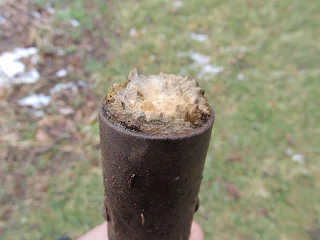A common, round pointed shovel with a broken handle. I bet you have a few of these lying around in your barn or garage.
What might it be good for?
 |
| This one was in a tree, stuffed into the end of a 25' run of sewer pipe. It was
a "snake" to scare the kiddies on Halloween. Can you see the eyes? |
I was curious about the material's resistance to puncture.
Kids: Don't try this at home. One of the rules of shooting is to not shoot at targets that can ricochet.
124 grains of hollowpoint applied at 1100 feet per second. Yes, it broke the handle off.
 |
| It stopped the bullet. Caution: This is one shovel, one round of ammo. This tells you very little about the performance of the population of all shovels and all types of 9mm ammo. |
 |
| You can judge the area of the deformation (or dent) by the clean area where the rust was knocked off. That is one of the ways body shops judge which suspension components were damaged in an accident. |
|
The steel of this cheap ($6 at a big-box store), made-in-Asia shovel is about 0.075, or 14 gauge (between 1.8 and 2.0mm). I don't know what grade of steel it is made of but you would probably be pretty close (or better) if you used
780 TRIP steel or
M1300 Martensitic sheet steel
 |
| To show the depth and profile of the dent |
 |
| The dent is about 0.3 inches deep. |
This blog is for grown-ups.
Don't read any more into this post than was written. For example, I
never suggested that a shovel could be used as a field expedient chicken plate. I did
not imply that 14 gauge 780 TRIP or Martensitic steel would be the absolute, bare minimum for making exterior doors resistant to common pistol bullets. Nope, I never wrote anything like that.








I wouldn't try that with a shovel today... :-)
ReplyDelete